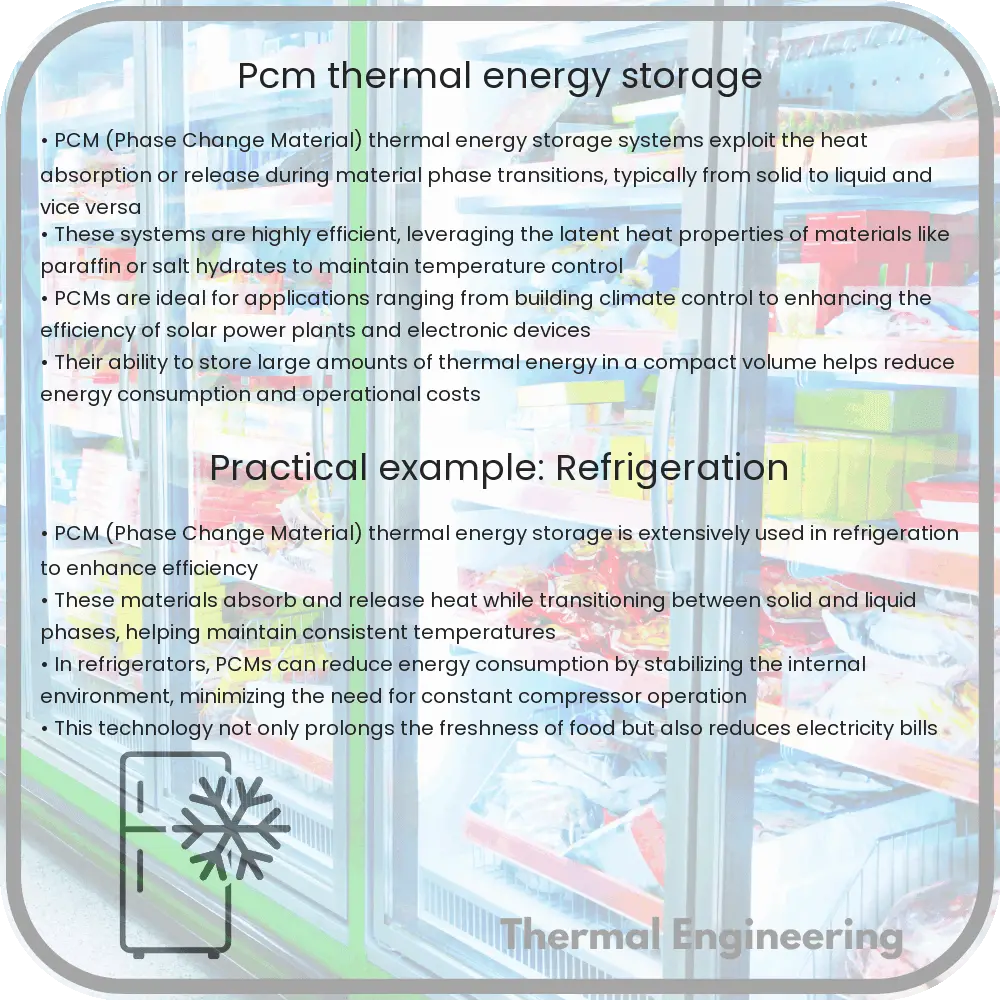Learn about Phase Change Material (PCM) thermal energy storage, a method using materials that store and release energy during phase changes.

Introduction to PCM Thermal Energy Storage
Phase Change Material (PCM) thermal energy storage is an innovative approach to storing and managing thermal energy efficiently. This technology exploits the heat absorbed or released during the phase change of a material, typically between solid and liquid phases. PCM thermal energy storage offers significant benefits in various applications, ranging from heating and cooling in buildings to maintaining temperature control in electronic devices and renewable energy systems.
Understanding Phase Change Materials
Phase Change Materials are substances with a high heat of fusion which, during melting and solidifying at a particular temperature, are capable of storing and releasing large amounts of energy. Common PCM materials include paraffin waxes, fatty acids, and salt hydrates. Each type of PCM is chosen based on its melting point, thermal conductivity, density, and chemical stability, matching the specific requirements of the application.
How PCM Thermal Energy Storage Works
The basic principle behind PCM thermal energy storage lies in the material’s ability to absorb and release heat during phase transitions. When a PCM reaches its melting point, it absorbs a significant amount of heat from its environment. This process is called “latent heat storage”. The PCM absorbs heat without increasing in temperature. Conversely, when the ambient temperature drops, the PCM releases the stored heat as it solidifies, thereby maintaining a constant temperature in its vicinity.
Advantages of PCM Thermal Energy Storage
- Energy Efficiency: PCM thermal energy storage can enhance energy efficiency by levelling the load on heating and cooling systems, reducing the peak demand and smoothing out the demand spikes.
- Temperature Stability: The ability of PCMs to maintain a consistent temperature during the phase change process makes them ideal for applications requiring precise temperature control.
- Flexibility: PCMs can be incorporated into various materials and systems, including wallboards, flooring, and even textiles, offering versatile solutions for managing thermal energy.
- Cost-Effectiveness: By potentially reducing the need for mechanical cooling and heating systems, PCMs can help lower energy costs.
Applications of PCM Thermal Energy Storage
PCM thermal energy storage finds applications in numerous fields:
- Building Temperature Control: In building construction, PCMs are used in walls, floors, and roof systems to reduce indoor temperature fluctuations and decrease the heating and cooling costs.
- Renewable Energy Systems: In solar power plants, for example, PCMs can store excess heat generated during the day and release it at night, thus extending the hours of operation.
- Thermal Management in Electronics: PCMs help maintain operational temperatures of electronics, thereby protecting sensitive components and extending their lifespan.
- Temperature-controlled Transportation: PCMs are also used in containers and packaging to stabilize product temperatures during shipping and handling, ideal for perishable goods or pharmaceuticals.
Challenges in PCM Thermal Energy Storage
Despite its advantages, PCM thermal energy storage also faces several challenges that need to be addressed to enhance its widespread adoption:
- Cost of Materials: High-quality PCMs can be expensive, impacting the cost-effectiveness of PCM deployment in large-scale systems.
- Integration with Existing Systems: Integrating PCMs into existing infrastructures like buildings and vehicles may require significant modifications, which can be a barrier for retrofit projects.
- Sustainability Concerns: Some phase change materials can be hazardous or have environmental impacts, making material choice critical from a sustainability perspective.
Conclusion
PCM thermal energy storage represents a promising technology that leverages the unique properties of phase change materials to improve energy efficiency and stability in various applications. As research continues and solutions to current challenges are developed, the role of PCMs in energy systems is likely to grow, offering significant benefits in terms of sustainability and efficiency in thermal management solutions.